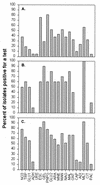Physiological diversity of the rhizosphere diazotroph assemblages of selected salt marsh grasses
- PMID: 9797277
- PMCID: PMC106639
- DOI: 10.1128/AEM.64.11.4276-4282.1998
Physiological diversity of the rhizosphere diazotroph assemblages of selected salt marsh grasses
Abstract
Rhizosphere diazotroph assemblages of salt marsh grasses are thought to be influenced by host plant species and by a number of porewater geochemical parameters. Several geochemical variables can adversely affect plant productivity and spatial distributions, resulting in strong zonation of plant species and growth forms. This geochemically induced stress may also influence the species compositions and distributions of rhizosphere diazotroph assemblages, but little is currently known about these organisms. The diversity and key physiological features of culturable, O2-tolerant rhizosphere diazotrophs associated with the tall and short growth forms of Spartina alterniflora and with Juncus roemerianus were examined. A total of 339 gram-negative strains were isolated by a root stab culture approach and morphologically and physiologically characterized by using API and BIOLOG tests. Eighty-six distinct groups composed of physiologically similar strains were identified. Of these groups, 72% were shown to be capable of N2 fixation through molecular analyses, and a representative strain was chosen from each diazotroph group for further characterization. Cluster and principal-components analysis of BIOLOG data allowed the designation of physiologically distinct strain groupings. Most of these groups were dominated by strains that were not identifiable to species on the basis of API or BIOLOG testing. Representatives of several families including the Enterobacteriaceae, Vibrionaceae, Azotobacteraceae, Spirillaceae, Pseudomonadaceae, and Rhizobiaceae were recovered, as well as strains with no clear taxonomic affiliations. This study identifies numerous potentially important physiological groups of the salt marsh diazotroph assemblage.
Figures



References
-
- American Type Culture Collection. Catalogue of bacteria and bacteriophages. Rockville, Md: American Type Culture Collection; 1992.
-
- Atlas R M. Handbook of microbiological media. Boca Raton, Fla: CRC Press, Inc.; 1993.
-
- Bagwell C E, Lovell C R, Piceno Y M, Ashburne A L. Abstracts of the 97th General Meeting of the American Society for Microbiology 1997. Washington, D.C: American Society for Microbiology; 1997. Differences between diazotrophic assemblages from the rhizosphere of salt marsh grasses, abstr. N-208; p. 415.
-
- Bally R, Thomas-Bauzon D, Heulin T, Balandreau J, Richard C, De Ley J. Determination of the most frequent N2-fixing bacteria in a rice rhizosphere. Can J Microbiol. 1983;29:881–887.
Publication types
MeSH terms
Substances
LinkOut - more resources
Full Text Sources
Molecular Biology Databases

